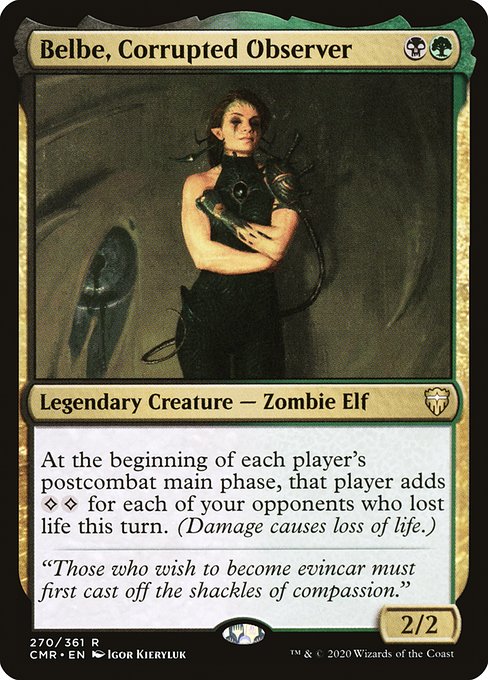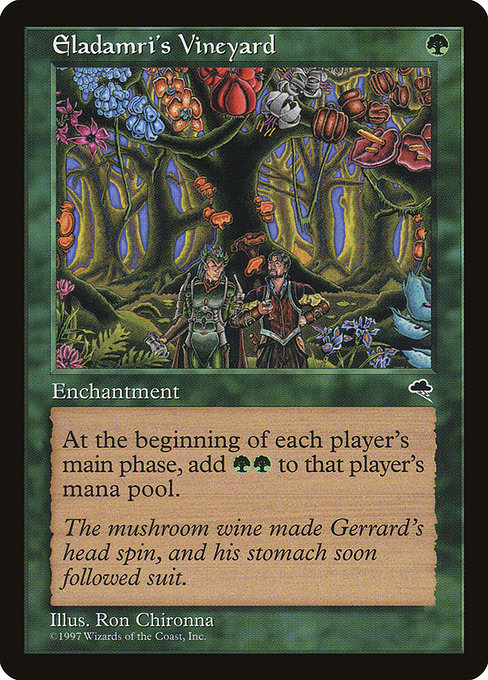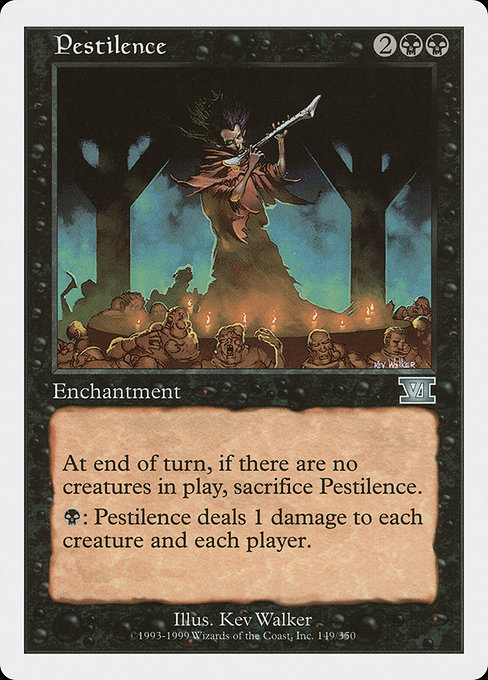We’re deep in Commander Legends spoilers now, and between Lotuses and Scroll Racks and embossed foils, excitement abounds. For me though, the most exciting card spoiled so far is an assuming 2/2 for two mana who’s preselling for near-bulk rates: Belbe, Corrupted Observer.

Belbe, once known as Avila, was the daughter of Eladamri, the elf king on the plane of Rath who rebelled against Phyrexian control. She was assassinated and reanimated to wound him and to serve as the arbiter of the evincar showdown between Ertai, Greven il-Vec, and Crovax. A Phyrexian recording device was planted in her (Eye of Yawgmoth) and she was sent to the artificial plane to observe the three and test their ambition. While on Rath, she and Ertai, who was in the process of being compleated and tortured by Greven il-Vec, fell in love; and she became an active participant in the contest, pushing Ertai to defeat Crovax. Eventually, though, Crovax prevailed, and Belbe was killed by her grieving father.
She’s a deeply tragic character: someone manipulated by sinister forces, someone whose past has been carved out of her, physically and metaphysically, someone who embodies the atrocities of Phyrexia and the perdurability of humanity. Metatextually, she’s also a tragic character. While she’s treated as a complex and appealing character in the Nemesis novel, her two showcase cards in the set are Murderous Betrayal and Belbe’s Portal, where she’s respectively asleep and dead.
All of this is recounted in Paul B. Thompson’s Nemesis, one of the better tie-in novels produced for a Magic set. Rich Stein has the best recap and analysis of the book, which you can find here, but I want to highlight what makes the novel—and the character of Belbe—work. Phyrexia’s downfall results from Yawgmoth entrusting Crovax, which is one of my favorite aspects of the Weatherlight Saga. Despotism hiding its own destruction in its brutal tactics was a resonant concept then and even more so now. Belbe sets up that dynamic—she supports Ertai’s claim after seeing Crovax’s brutality firsthand and reclaiming some of her empathy.
Nemesis is also unique within the Magic universe—almost all of the characters in the book are villains. There’s a hierarchy of villainy, of course—Crovax and Volrath are true villains, whereas Ertai, Greven, and Belbe are tragic antiheroes; but it’s extremely rare to have any nuanced villains in Magic, let alone several in one book. Ertai, abandoned on Rath by his friends/employers, has his arrogance and humanity stripped from him as he becomes more and more physically monstrous and magically potent. His arc is one of ongoing trauma.
Greven, the archetypal henchman, turns down power because he’d rather serve in Hell than rule over it. Volrath, the abdicator, returns to reclaim the throne, but he is outclassed by the malice and power of Crovax (assisted in his eventual victory by Ertai). The stakes of the ongoing Magic story are effectively elevated in the novel, all through the character arc of Belbe.
So when we saw Belbe, Corrupted Observer last week, I was initially disappointed—a bear with a drawback seemed a bit more Belbe’s Percher than Belbe’s Portal, if you get my drift. But after spending some hours scrounging through EDHREC and riffing in various group chats, I’m much more enthused. Much like in Nemesis, she might not be as overtly powerful as the other Legends in her set, but in her own way she affects everything around her.

Her ability harkens back to Eldamri’s Vineyard, but with a Phyrexian twist. As judge and Phyrexia’s representative, she was meant to remain a neutral party (although her relationship with Ertai and fear of Crovax influenced her). Thus, her mana is <><> instead of GG, and it’s theoretically egalitarian—although if she’s your general, you can be all but guaranteed that you’ll be coming out ahead. Let’s explore how to do just that.
First, I would note that one of the options I always consider for G/B decks—Infect—doesn’t work with Belbe. Infect doesn’t cause a loss of life, so you’re out of luck there. That seems off-flavor for a Phyrexian legend, but you can’t win them all. Another great Golgari archetype is a much better fit, though—Pox. Between Smallpox, Pox, Death Cloud, Rankle, Master of Pranks, and various Hurricane and Famine effects, you can control the board, trigger Belbe, and seriously aggravate your opponents.
Belbe is obviously great in CEDH—with no other opponents, her drawback is diminished (although your opponent can damage themselves to take advantage of her trigger, so watch for fetchlands). Dropping her turn one with a 0-cost mana artifact (which the CEDH arms race mentality demands) allows you to ramp to four on turn two if she connects. In multiplayer games, she scales based on the number of players. Ideally, you play a one-drop on turn one, Belbe on turn two, then swing on turn three at two opponents who had a slower start and make seven mana post-combat (four colorless from Belbe, plus your three lands). If you want to alienate your playgroup or win a competitive match, it would be very easy to build a Stax-style Belbe deck that ramps out a turn three Karn Liberated, Immortal Sun, or God-Pharaoh’s Statue. If you want to go this direction, I—and Belbe—thoroughly support it. But there are more friendly ways to play.
Cards that deal damage directly and repeatedly to opponents are necessary for a Belbe deck—luckily, they’re numerous in Golgari colors. Creeping Dread is a diverting minigame that can bolt several opponents at once, and I have a foil Cryptolith Fragment that’s been languishing in my binder for years that belongs in a Belbe deck. Crypt Ghast and Pontiff of Blight are auto-includes, of course. (Thrull Parasite is less of a requirement, but worth considering.)
Shepherd of Rot, Triskaidekaphobia, Hooded Blightfang, Ill-Gotten Inheritance, Slimefoot, the Stowaway, and all Blood Artist effects are great ways to consistently and predictably trigger Belbe, even on your opponents’ turns. That may be the best way to play Belbe: as what I’ll call a group bear hug—everyone is getting just a little bit hurt, but not enough to justify taking out the Belbe pilot.

The real crux of a Belbe strategy is a simple card that goes all the way back to Alpha: Pestilence. Pestilence effects now allow you to turn (B) into (<>)(<>)(<>)(<>)(<>)(<>) in a three-player game, and gives you the option to also activate it politically on other players’ turns to help them out with a burst of mana. Fellow Mercadian Masques block stalwart Thrashing Wumpus will also work, as will Pestilence Demon and former Standard all-star Plague Spitter.
Festering Evil is perfect for Belbe, and Screams of the Damned is an option. EDHREC currently has 28 decks out of 415,600 playing Whirling Catapult; I intend to make that 29. I default to playing Snow-Covered lands in my Commander decks, because I opened a lot of Ice Age back in the day; so, if you’re anything like me, you can play Withering Wisps as a backup Pestilence.
If you want to be a little more cutthroat, you can add Archfiend of Despair and Wound Reflection. I love this build of a Belbe deck more than any other—you have so much control over the board and over Belbe’s trigger with a simple Pestilence effect. That said, you’ll need to find a way to make Belbe a bit sturdier than a 2/2—Sword of Feast and Famine would be an on-flavor pick.
In the Nemesis novel, Belbe was exploited, not a villain. Her goals may have been opposed to our heroes back on the Weatherlight, but she was impartial in the larger conflict. (Although Belbe passively enabled the Phyrexian invasion and Dominarian apocalypse as a tool of Yawgmoth.) I always identified with her a bit—she was doing what she was literally made to do, until she realized she had other options.
There’s so much resonance in that character arc, especially when you’re young, and the world is both limitless and very, very dependent on what other people tell you your options are. Now that she’s been printed in a form that prioritizes recurring damage, while also opening up a way to assist other players, her flavor comes through perfectly. Her existence is an abomination, driving her father close to madness and perverting the life/death binary, but she’s here to help. She just doesn’t want to ask too many questions about precisely who she’s helping. There’s some resonance in that, too.
A lifelong resident of the Carolinas and a graduate of the University of North Carolina, Rob has played Magic since he picked a Darkling Stalker up off the soccer field at summer camp. He works for nonprofits as an educational strategies developer and, in his off-hours, enjoys writing fiction, playing games, and exploring new beers.

